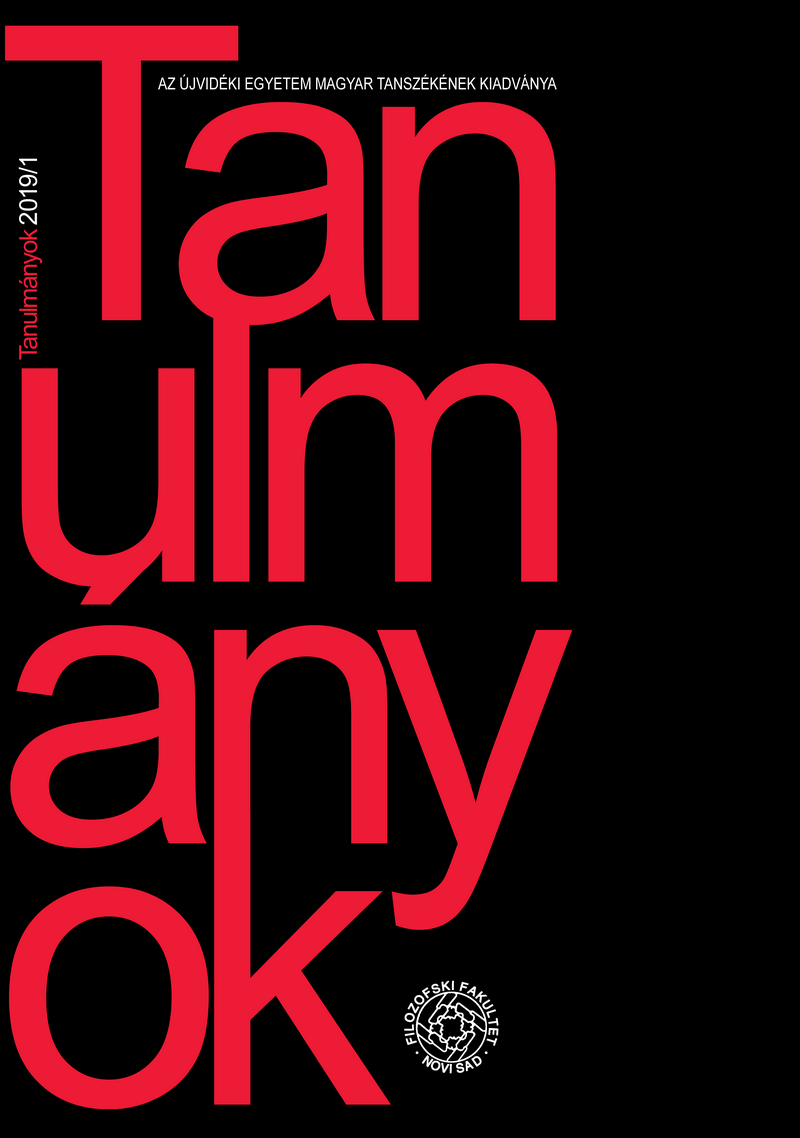OLVASNI A SZÖVETET
A szöveg mint szövet hermeneutikája és James Joyce Ulyssese
Absztrakt
Jóllehet mára nyilvánvalónak tűnik, hogy a nyelv nem „transzparens médium”, a szövegek narratíváira koncentráló értelmezések száma még mindig meghaladja azon erőfeszítésekét, melyek a szöveg beszédmódjainak feltárására helyezik a hangsúlyt. A csupán a szövegekTanulmányok, Újvidék, 2019/1. 58. füzet, 57–77. narratíváját vizsgáló interpretációk nem veszik figyelembe a kérdést, hogy a szöveg mit mond azáltal, ahogy beszél. Az értelmezés feltételezett fonalait és a szövegben rejlő szimbolikát kutatják. A hermeneutikai feladat abban áll, hogy dialógusba kerüljünk a szöveggel. A dialógus akképp jön létre, hogy a szöveg fenomenális felületét kérdezzük, azaz a szövegszövet összefüggéseinek feltárására teszünk kísérletet. Vagyis fel kell tennünk a kérdést, hogyan szólít meg bennünket a szöveg, mikor az olvasás során hozzánk beszél, s ezt hogyan halljuk meg. Hogy magát a szöveget mint szövetet tegyük láthatóvá a hermeneutikai interpretáció során, a jel fenomenális értelmét, a nyelv mint beszéd értelmét, a meghallás jelentőségét, valamint a szöveg terének mibenlétét egyaránt fel kell tárnunk. Ilyenformán az olvasás során követhetővé válnak az észlelés, az értelem-összefüggések, valamint az érintettség összefonódó fonalai, s a szöveg mértéke szerint szabott betekintést nyerhetünk abba, ami benne rejlik. A James Joyce Ulysseséből származó idézetek tanúsítják, hogy az irodalmi szöveg eminens kibontakozása során nem tekinthetünk el a szövet fenomenális értelmezhetőségének eltérő vetületeitől.
Hivatkozások
Breuer, Dieter. 1990. Vorüberlegungen zu einer pragmatischen Textanalyse. In: Rhetorik. Erster Band: Rhetorik als Texttheorie. 91–128. Herausgegeben von Josef Kopperschmidt. Darmstadt: Wissenschaftliche Buchgesellschaft.
Burgess, Anthony. 1973. Joysprick: An Introduction to the Language of James Joyce. NewYork and London: Harcourt Brace Jovanovich.
Culler, Jonathan. 2015. Theory of the Lyric. Cambridge, Massachusetts, London, England: Harvard University Press.
Figal, Günter. 2010. Erscheinungsdinge: Ästhetik als Phänomenologie. Tübingen: Mohr Siebeck. Frank, Manfred. 1977. Das Individuelle Allgemeine: Textstrukturierung und -interpretation nach Schleiermacher. Frankfurt am Main: Suhrkamp.
Frank, Manfred. 1990a. Das ‘einzelne Allgemeine’ des Stils: Anmerkungen zur Hermeneutik Jean Starobinskis. In: Das Sagbare und das Unsagbare: Studien zur deutsch-französischen Hermeneutik und Texttheorie. 239–255. Frankfurt am Main: Suhrkamp.
Frank, Manfred. 1990b. Was ist ein literarischer Text, und was heißt es, ihn zu verstehen? In Das Sagbare und das Unsagbare: Studien zur deutsch-französischen Hermeneutik und Texttheorie. 121–195. Frankfurt am Main: Suhrkamp.
Frost, Robert. 1995. Collected Poems, Prose and Plays. New York: The Library of America.
Gadamer, Hans-Georg. 1972. Semantik und Hermeneutik. In Kleine Schriften III: Idee und Sprache. 251–260. Tübingen: Mohr-Siebeck.
Gadamer, Hans-Georg. 1993a. Der ‘eminente’ Text und seine Wahrheit. In Ästhetik und Poetik Kunst als Aussage. Gesammelte Werke Band 8. 286–295. Tübingen: Mohr Siebeck.
Gadamer, Hans-Georg. 1993b. Dichten und Deuten. In Ästhetik und Poetik I: Kunst als Aussage. Gesammelte Werke Band 8. 18–24. Tübingen: Mohr Siebeck.
Gadamer, Hans-Georg. 1993c. Gedicht und Gespräch. In Ästhetik und Poetik II: Hermeneutik im Vollzug. Gesammelte Werke Band 9. 335–346. Tübingen: Mohr-Siebeck.
Gadamer, Hans-Georg. 1993d. Hören-Sehen-Lesen. In Ästhetik und Poetik I: Kunst als Aussage. Gesammelte Werke Band 8. 271–278. Tübingen: Mohr Siebeck.
Gadamer, Hans-Georg. 1993e. Lesen ist wie Übersetzen. In Ästhetik und Poetik I: Kunst als Aussage. Gesammelte Werke Band 8. 279–285. Tübingen: Mohr Siebeck.
Gadamer, Hans-Georg. 1993f. Philosophie und Literatur. In Ästhetik und Poetik I: Kunst als Aussage. Gesammelte Werke Band 8. 240–257. Tübingen: Mohr Siebeck.
Gadamer, Hans-Georg. 1993g. Philosophie und Poesie. In Ästhetik und Poetik I: Kunst als Aussage. Gesammelte Werke Band 8. 232–239. Tübingen: Mohr Siebeck.
Gadamer, Hans-Georg. 1993h. Stimme und Sprache. In Ästhetik und Poetik I: Kunst als Aussage. Gesammelte Werke Band 8. 258–270. Tübingen: Mohr Siebeck.
Gadamer, Hans-Georg. 1995a. Dekonstruktion und Hermeneutik. In Hermeneutik im Rückblick. Gesammelte Werke Band 10. 138–147. Tübingen: Mohr Siebeck.
Gadamer, Hans-Georg. 1995b. Hermeneutik auf der Spur. In Hermeneutik im Rückblick. Gesammelte Werke Band 10. 148–174. Tübingen: Mohr Siebeck.
Gadamer, Hans-Georg. 1997a. Von der Wahrheit des Wortes. In Gadamer Lesebuch. 120–140. Tübingen: Mohr-Siebeck.
Gadamer, Hans-Georg. 1997b. Wort und Bild – ‘so wahr, so seiend.’ In Gadamer Lesebuch. 172–198. Tübingen: Mohr-Siebeck.
Joyce, James. 1986. Ulysses. Edited by Hans Walter Gabler with Wolfhard Steppe and Claus Melchior. New York: Vintage Books.
Lotman, Yuri. 2012. Defamiliarization. In The Princeton Encyclopaedia of Poetry and Poetics. Edited by Roland Greene, et. al. Princeton and Oxford: Princeton University Press.
de Man, Paul. 2002. Hypogram and Inscription. In The Resistance to Theory. 27–53. London, Minneapolis: University of Minnesota Press.
Ricoeur, Paul. 1981. The Hermeneutical Function of Distanciation. In Hermeneutics and the Human Sciences. 131–144. Edited and translated by John B. Thompson. Paris–New York: Maison des Sciences de l’Homme and Cambridge University Press.
Ricoeur, Paul. 1974. Structure, Word, Event. In The Conflict of Interpretations: Essays in Hermeneutics. 79–98. Evanston, Illinois: Northwestern University Press.
Riedel, Manfred. 1990. Hören auf die Sprache: Die akroamatische Dimension der Hermeneutik. Frankfurt am Main: Suhrkamp.
Schlauch, Margaret. 1974. Character as Linguistic Mode: A New Look at Streams-of-Consciousness in ‘Ulysses. In: Ulysses: Cinquante Ans Après: Témoignages Franco-Anglais sur le Chef-d’ɶuvre de James Joyce, rassemblés par Louis Bonnerot avec la collaboration de J. Aubert et Cl. Jacquet. 111–130. Paris: Libraire Marcel Didier.







